Calamint / Spring /Summer / Autumn / Edible
Common Names
Calamint
Botanical Name
Clinopodium ascendens
Scientific Classification
Kingdom – Plantae
Order –Lamiales
Family – Lamiaceae
Physical Characteristics of Calamint
An upright perennial herb, 30 – 60cm tall.
Leaves
Leaf stalks green, 1cm long, leaves are greyish green, oval with blunt tips and truncated base, 2-4 x 1-3cm long with adpressed hairs and shallow blunt teeth and hairs that lie flat against the leaf
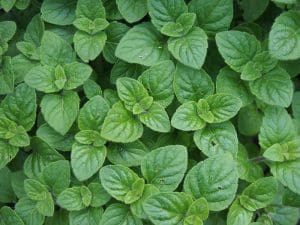
Stem
One main stem with several long branches at a 45-degree angle.
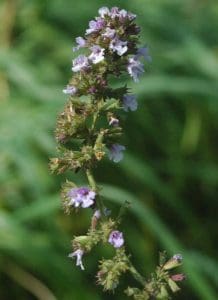
Flowers
The flowers grow in whorls around the stem, in the leaf axils along the top third of the plant. The pale pinkish-white flowers are tubular, divided into four lobes at the mouth and sit within a green hairy cup, called a calyx. The flowers are 10-15mm long with small purple spots on the lower lip.
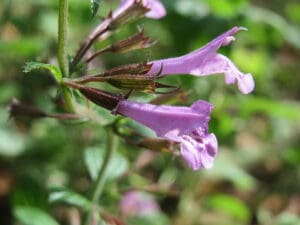
Habitat
Up to 380m. In England, most widespread in Norfolk and in the south-west as far east as Salisbury plain. It is less common in the rest of the British Isles; not found in Scotland or parts of Wales.
Dry, grassy areas on woodlands edges or paths, hedge-banks, scrub, road verges, usually on alkaline soil. It cannot grow in the shade and prefers dry or moist soil.
Known Hazards
Many of our favourite culinary herbs belong to the mint family, which is characterised by the presence of aromatic oils in many of its species. These enable to plants to retain moisture in the hot, dry conditions that many of them seem to prefer, and also repel insects and herbivore predators by their pungent bitter taste.
However, one source states that Calamint should not be prescribed for pregnant women since in excess it can cause a miscarriage.
Potential lookalikes
Pennyroyal (Mentha pulegium) is a creeping perennial herb up to 30cm long. The oval leaves are smaller than Calamint, 1-2cm long x 0.5-1cm wide and have shorter stalks. The flowers are more clumped in distant whorls in leaf axils.
Pennyroyal contains pulegone, which causes liver damage if consumed in large amounts. Ingestion of Pennyroyal essential oil extracts has caused adult poisonings. A baby is recorded has having died from liver damage due to repeated doses of Pennyroyal tea to treat colic. Babies and embryos have much less liver tissue than adults so pregnant women should not consume Pennyroyal.
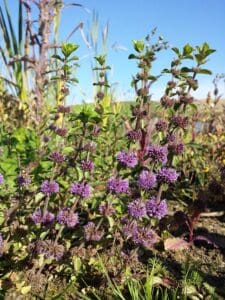
Field Woundwort (Stachys arvensis). The leaves have more defined teeth and the calyx has equal length teeth, all splaying outward. Corollas are smaller (6-7mm long) and are described as pink with purple streaks (rather than spots). Poisonous to cattle, horses, pigs and sheep.
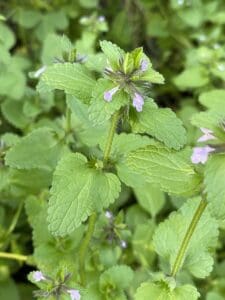
Catmint (Nepeta cataria). The leaves are coarsely toothed. The flowers form an oblong head of dense whorls, rather than being spaced in leaf axils along the top third of the stem. The calyx is downy with 5 straight teeth. The corolla is a 12mm, two lipped, curved tube – white with purple dots. Edible.

Wood sage (Teucrium scorodonia). Wood sage is not that similar in appearance to Calamint having untoothed oval leaves with cordate base in well spaced pairs and cream coloured flowers in opposite pairs on long branched spikes. Wood sage contains clerodane diterpenes which can cause liver damage so this plant should not be eaten regularly or in any quantity.
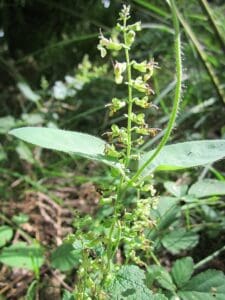
Edible Uses
The mint flavour of Calamint is more delicate than the flavours of water mint, peppermint or spearmint. The delicate flavour works well with elderflower sorbet, which other mints may overpower. Infuse in warm liquids rather than boil, so as to avoid losing the aromatic oils.
The plant is known for its medical uses in folk medicine and as a spice in Italian kitchens. In Madeira Island the local population uses the leaves of calamint as a mouth freshener and to alleviate headache and toothache.
The essential oil has shown remarkable activity against some bacteria.
Notes on Herbal uses
Lesser calamint was commonly used as a medicinal herb in medieval times, though is little used by modern herbalists. It is sometimes cultivated as a medicinal herb for household use. The leaves are harvested as the plant comes into flower and are dried for later use. An infusion is beneficial in cases of flatulent colic and weaknesses of the stomach, it is also used to treat depression, insomnia and painful menstruation.
Extra notes from the Foragers
The species is hermaphrodite (has both male and female organs). It is noted for attracting wildlife; it is pollinated by bees and other insects. Calamintha species are used as food plants by the of some species including moths.
Calamint was a great favourite of the old herbalists. Gerard suggested twelve uses to which it could be put “without fear of failure.” According to him, it would not only cure the bite of a poisonous snake, it would also drive the serpent off if burned or scattered. On the same theme, Calamint was said to drive off the basilisk.
Calamint would heal bruises received from a beating or blow, though Galen suggests it be used fresh rather than dried for this purpose. As a tea or bathing herb, it may be used to sooth away sorrows and recover from emotional pain. It is also suggested to sooth the nerves and strengthen the body in a bath. One drop of oil, put onto a wad of wool, will sooth a toothache according to the old herbalists. Placed by milk in a dairy, it will prevent the milk from being turned by thunder.



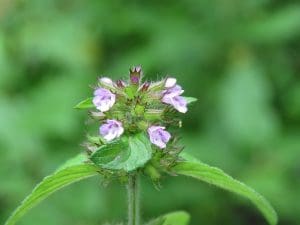
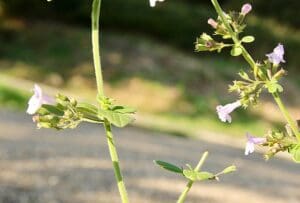
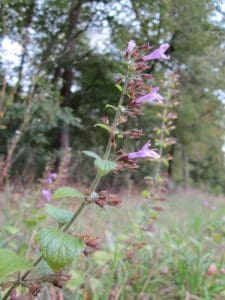



Leave a Reply
You must be logged in to post a comment.